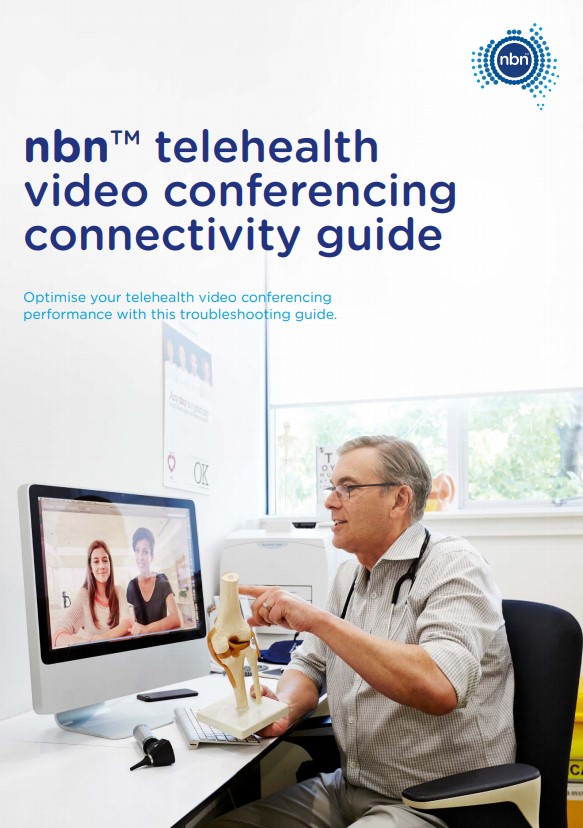Making the most of telehealth: meet Emma and George
Thanks to help from connectivity – like services over the nbn™ network – and allied health providers, Australians are increasingly taking advantage of the benefits of telehealth.
Accessing healthcare virtually though telecommunications has many benefits, like the ability to access care sooner, less travel costs, convenience and even a reduced risk of infection for the community’s most vulnerable.
In Australia, more than 54 million Medicare-subsidised telehealth services had been delivered to 13.5 million patients over the year until the end of March.*
Emma Small and her 11-year-old son George, who live in Dubbo, New South Wales, are just some of those Australians now accessing telehealth.^

“George and I are much more comfortable,” says Emma, about accessing treatment via telehealth.
“It just makes it easy, a lot more natural, and he’s happy to be at home.”
Telehealth is undoubtedly helping regional, rural and remote Australians, and has grown during the recent COVID-19 lockdowns.
“As a result of the pandemic, virtual healthcare is becoming a permanent feature in the Australian healthcare system, in particular for those who have difficulty accessing care due to time, cost or location,” says Jen Beer, Head of Segment – Health and Education at nbn.
These services range from diagnosis and treatment through video and phone consults, to sending data from wearable devices tracking a patient’s vitals to their medical specialist, through to more preventative activities, such as learning about healthy lifestyle choices that reduce the risk of developing cancer or diabetes.


Helping to overcome barriers
While the COVID-19 pandemic has helped fuel acceptance of digital healthcare delivery, there are still barriers to overcome, says Jen.
Just seven per cent of the 43 million telehealth consults conducted in the nine months to December 2020 were via video.
“Excitingly, as we work to fulfil our purpose to lift the digital capability of Australia, nbn is playing a key role in overcoming some of these barriers,” says Jen.
One example of this is the nbn™ telehealth video conferencing connectivity guide designed to lift confidence and digital literacy by helping healthcare providers solve common issues encountered when conducting a consultation over video.
Jen says education is key to communicating what the nbn™ network is capable of supporting.
“Services over the nbn™ network help turn homes into virtual hospital wards; tin sheds in remote East Arnhem into telehealth suites; local libraries into medical school amphitheatres; and, in the case of Therapy Connect, home offices into consulting rooms.
“It helps create equitable access for people living across Australia to quality healthcare, when they need it.”

Telehealth in the 2020s
While telehealth has been around for more than 20 years, it took a pandemic to turn healthcare delivery in Australia on its head.
Over the year to the end of March, more than 54 million Medicare-subsidised telehealth services were delivered to 13.5 million patients. More than 83,000 providers have offered the services and almost $2.8 billion in Medicare benefits were paid.*
Factors contributing to the greater adoption of telehealth services during the COVID-19 pandemic include:
Telehealth subsidies
In March 2020, as the pandemic struck, the Federal government rapidly rolled out telehealth subsidies so that Australians could continue to access General Practitioner, mental health, and allied health services at a subsidised rate.
The benefits experienced as a result of the substantial take-up led to the Government extending many of these subsidies until the end of 2021, and cross-industry collaboration to ensure telehealth remains a mainstay of healthcare delivery long term.
What’s next for healthcare?
We’ve only scratched the surface of what’s possible through virtual care.
Beyond telehealth, we’re seeing the likes of surgery performed by robots; mobile health devices alerting a change in a patient’s condition before they know anything is happening; electronic medical records helping healthcare providers achieve truly patient-centric care; virtual reality helping multidisciplinary surgical teams plan their approach; and artificial intelligence, big data and quantum computing helping diagnose patients and develop treatment plans.
What these solutions have in common is the need for a fast internet connection – and that’s where nbn comes in. Over the coming 12 months, nbn will continue working with governments, peak industry bodies, research groups, and state organisations to help increase understanding of the benefits of virtual healthcare, and the important role the nbn™ network can play in supporting the future of healthcare delivery in Australia.
* Federal budget: Government to extend telehealth funding until end of 2021 (smh.com.au)
^ nbn is very happy with Therapy Connect, Emma and George’s experience with the nbn™ network. Of course, end customer experiences may vary. An end customer’s experience, including the speeds actually achieved over the nbn™ network, depends on the nbn™ access network technology and configuration over which services are delivered to their premises, whether they are using the internet during the busy period, and some factors outside of nbn’s control (like their equipment quality, software, chosen broadband plan, signal reception, or how their provider designs its network). Speeds may also be impacted by the number of concurrent users on the nbn™ Fixed Wireless network, including during busy periods. Sky Muster™ satellite end customers may also experience latency.



